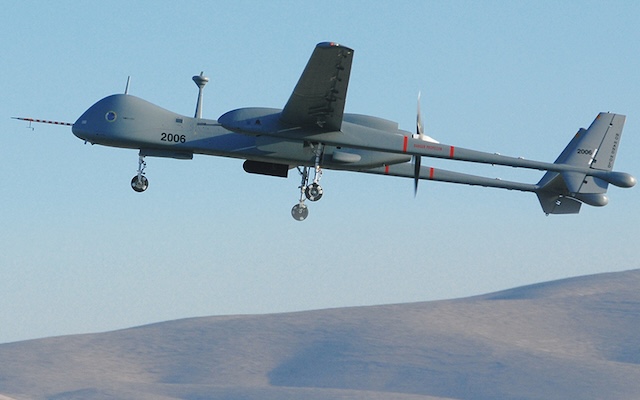Eitan (Heron TP)
Summary
| Category | Military Drones |
| Origin country | 🇮🇱 Israel |
| Manufacturer | IAI |
| First flight | 1 January 2004 |
| Year introduced | 2010 |
| Number produced | units |
Description
The IAI Eitan, also known by its export designation Heron TP, is an unmanned reconnaissance aircraft developed by the Malat division of Israel Aerospace Industries in the early 21st century. It represents a newer version of the IAI Heron. The program's existence was first announced in April 2004, with initial reports suggesting prototypes were already in flight. The IAI Eitan officially conducted its first flight in Israel on 15 July 2006 and was publicly unveiled on 8 October 2007, at Tel Nof Airbase. A joint venture with US company Aurora Flight Sciences, aiming to market the aircraft as the Orion, was announced in March 2005.
The IAI Eitan is designed as a medium-altitude, long-endurance (MALE) UAV, capable of operating above commercial air traffic altitudes. Its design incorporates all-weather capabilities, de-icing systems, and automatic takeoff and landing (ATOL) systems. The aircraft is a high-wing cantilever monoplane distinguished by its high aspect ratio wings. Twin tail booms extend rearward, joined by a common horizontal stabilizer. The tricycle undercarriage features main units that retract into the tail booms, and a nosewheel that retracts into the fuselage. A single turboprop engine, mounted in the rear fuselage, drives a pusher propeller. The Eitan's construction utilizes composite materials throughout.
While primarily designed for intelligence, surveillance, target acquisition, and reconnaissance (ISTAR) roles, reports suggest the Israeli IAI Eitan is also capable of undertaking armed roles, potentially equipped with missiles attached to wing hardpoints. Alleged use in operations involving target acquisition and engagement has been reported. The IDF does not typically comment on the arming of its drones. The Eitan possesses a substantial payload capacity of 2,700 kg, which can be configured for various mission requirements, including integration of sensors, communications equipment, and munitions. There are conflicting reports on whether the exported Eitan's are unarmed or armed.
The Israeli Air Force formally introduced its Eitan fleet in February 2010. The first operational unit, 210 Squadron, was inaugurated at Tel Nof in December of the same year. One report indicates that the Eitan was deployed by Israel in a 2009 airstrike targeting an alleged Gaza-bound Iranian arms convoy traveling through Sudan. An Eitan drone crashed near Hafetz Haim in January 2012 during payload testing, but there were no reported injuries.
Main Variants:
Technical specifications
| Version: Eitan (Heron TP) | |
|---|---|
| Endurance | 36 hours |
| Maximum speed | 370 km/h (230 mph) |
| Wingspan | 26 m (85.3 ft) |
| Length | 14 m (45.9 ft) |
| Service ceiling | 12,500 m (41,011 ft) |
| Empty weight | 4,650 kg (10,251 lbs) |
| Max. takeoff weight | 5,670 kg (12,500 lbs) |
| Powerplant | 1 x Pratt & Whitney PT6A turboprop engine delivering None each |
